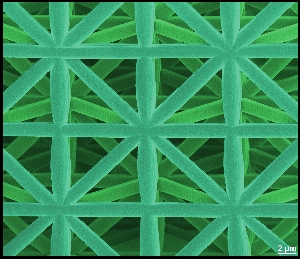“The novel lightweight construction materials resemble the framework structure of a half-timbered house with horizontal, vertical, and diagonal struts,” says Jens Bauer, Karlsruhe Institute of Technology (KIT). “Our beams, however, are only 10 µm in size.” In total, the lightweight construction elements are about 50 µm long, wide, and high.
“Nature also uses open-pore, non-massive structures for carrying loads,” Oliver Kraft, KIT, explains. Examples are wood and bones. At the same density, however, the novel material produced in the laboratory can carry a much higher load. A very high stability was reached by a shell structure similar to the structure of honeycombs. It failed at a pressure of 28 kg/mm2 only and had a density of 810 kg/m3. This exceeds the stability / density ratio of bones, massive steel, or aluminum. The shell structure produced resembles a honeycomb with slightly curved walls to prevent buckling.
To produce the lightweight construction materials, 3D laser lithography was applied. Laser beams harden the desired microstructure in a photoresist. Then, this structure is coated with a ceramic material by gas deposition. The structures produced were subjected to compression via a die to test their stability.
Microstructured materials are often used for insulation or as shock absorbers. Open-pore materials may be applied as filters in chemical industry.
High-strength cellular ceramic composites with 3D microarchitecture, Jens Bauer, Stefan Hengsbach, Iwiza Tesari, Ruth Schwaiger, and Oliver Kraft, PNAS Early Edition, DOI: 10.1073/pnas.1315147111
Being “The University in the Helmholtz Association”, KIT creates and imparts knowledge for the society and the environment. It is the objective to make significant contributions to the global challenges in the fields of energy, mobility, and information. For this, about 10,000 employees cooperate in a broad range of disciplines in natural sciences, engineering sciences, economics, and the humanities and social sciences. KIT prepares its 22,800 students for responsible tasks in society, industry, and science by offering research-based study programs. Innovation efforts at KIT build a bridge between important scientific findings and their application for the benefit of society, economic prosperity, and the preservation of our natural basis of life. KIT is one of the German universities of excellence.

